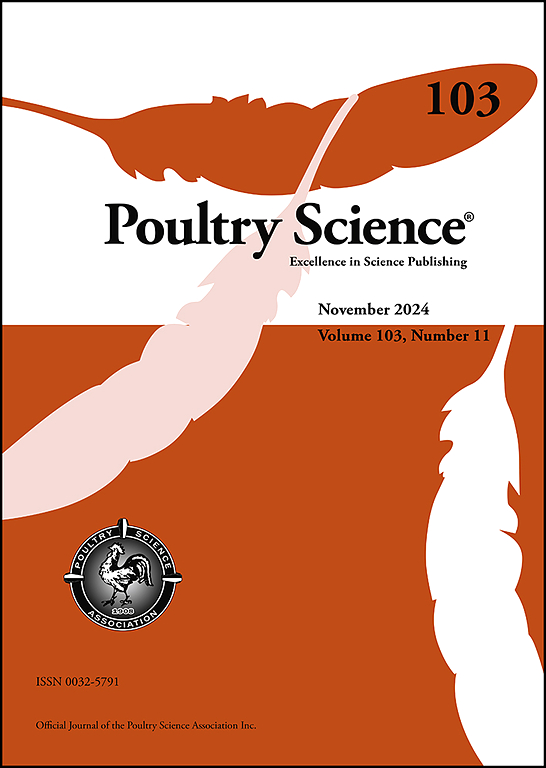一种新的禽腺病毒(A ~ E)种特异性多重PCR分化方法:在野外监测中的应用。
IF 4.2
1区 农林科学
Q1 AGRICULTURE, DAIRY & ANIMAL SCIENCE
引用次数: 0
摘要
禽腺病毒(FAdV)是一种非包膜二十面体DNA病毒,通过水平和垂直传播诱导包涵体肝炎(IBH)、肝炎心包水综合征(HHS)和砂囊侵蚀(GE),给家禽造成重大经济损失。FAdV包括5种(A-E)和12种血清型(1-7、8a、8b和9-11),它们经常在禽群中共同传播,因此早期准确检测对有效控制至关重要。在这里,我们开发了一种针对纤维和penton碱基基因保守区域的单管多重PCR检测方法,能够同时检测所有5种FAdV,灵敏度为25拷贝/管。当应用于79例自然感染fadv病例的125株田间菌株时,该检测与单链PCR和Sanger测序的一致性达到100%。在感染水平上,单种感染占53.2%,双种共感染占36.7%,三种感染占8.9%,四种感染占1.3%,其中以口蹄疫- d /E共感染最为普遍。在菌株水平上,FAdV-E最常见(34.4%),其次是D(31.2%)、B(20.0%)、C(8.0%)和A(6.4%)。此外,纤维、五边形和六邻体基因全序列的系统发育分析证实了物种特异性聚类与多重PCR结果完全一致。总之,这种快速、敏感、特异且具有成本效益的检测方法是一种强有力的工具,为改进家禽腺病毒疾病的管理和控制提供了基础。本文章由计算机程序翻译,如有差异,请以英文原文为准。
A novel species-specific multiplex PCR assay for the differentiation of five Fowl adenovirus species (A to E): Application to field surveillance
Fowl adenovirus (FAdV) is non‐enveloped, icosahedral DNA virus that cause significant economic losses in poultry by inducing inclusion body hepatitis (IBH), hepatitis‐hydropericardium syndrome (HHS), and gizzard erosion (GE) via both horizontal and vertical transmission. FAdV comprises five species (A-E) and twelve serotypes (1-7, 8a, 8b, and 9-11 ) that frequently co‐circulate within flocks, making early and accurate detection essential for effective control. Here, we have developed a single‐tube multiplex PCR assay targeting conserved regions of the fiber and penton base genes, capable of simultaneously detecting all five FAdV species with a sensitivity of 25 copies/tube. When applied to 125 field strains from 79 naturally FAdV-infected cases, the assay achieved 100 % concordance with singleplex PCR and Sanger sequencing. At the infection level, infection profiling showed 53.2 % single‐species cases, 36.7 % dual‐species co‐infections, 8.9 % triple‐species infections, and 1.3 % quadruple‐species infections, with FAdV-D /E co‐infections most prevalent. At the strain level, FAdV‐E (34.4 %) was the most common, followed by D (31.2 %), B (20.0 %), C (8.0 %), and A (6.4 %). Besides, phylogenetic analysis of the complete sequences of the fiber, penton base, and hexon genes confirmed species‐specific clustering perfectly aligned with the multiplex PCR results. Taken together, this rapid, sensitive, specific, and cost‐effective assay represents a powerful tool, providing a foundation for improved management and control of adenoviral diseases in poultry.
求助全文
通过发布文献求助,成功后即可免费获取论文全文。
去求助
来源期刊

Poultry Science
农林科学-奶制品与动物科学
CiteScore
7.60
自引率
15.90%
发文量
0
审稿时长
94 days
期刊介绍:
First self-published in 1921, Poultry Science is an internationally renowned monthly journal, known as the authoritative source for a broad range of poultry information and high-caliber research. The journal plays a pivotal role in the dissemination of preeminent poultry-related knowledge across all disciplines. As of January 2020, Poultry Science will become an Open Access journal with no subscription charges, meaning authors who publish here can make their research immediately, permanently, and freely accessible worldwide while retaining copyright to their work. Papers submitted for publication after October 1, 2019 will be published as Open Access papers.
An international journal, Poultry Science publishes original papers, research notes, symposium papers, and reviews of basic science as applied to poultry. This authoritative source of poultry information is consistently ranked by ISI Impact Factor as one of the top 10 agriculture, dairy and animal science journals to deliver high-caliber research. Currently it is the highest-ranked (by Impact Factor and Eigenfactor) journal dedicated to publishing poultry research. Subject areas include breeding, genetics, education, production, management, environment, health, behavior, welfare, immunology, molecular biology, metabolism, nutrition, physiology, reproduction, processing, and products.
 求助内容:
求助内容: 应助结果提醒方式:
应助结果提醒方式:


